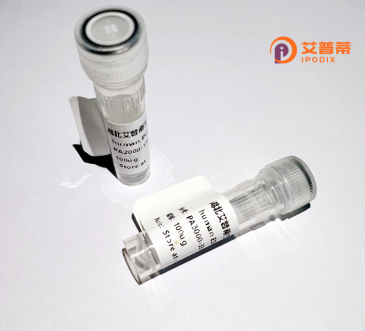
| 纯度 | >90%SDS-PAGE. |
| 种属 | Human |
| 靶点 | BHLHE40 |
| Uniprot No | O14503 |
| 内毒素 | < 0.01EU/μg |
| 表达宿主 | E.coli |
| 表达区间 | 1-412aa |
| 氨基酸序列 | MERIPSAQPPPACLPKAPGLEHGDLPGMYPAHMYQVYKSRRGIKRSEDSKETYKLPHRLIEKKRRDRINECIAQLKDLLPEHLKLTTLGHLEKAVVLELTLKHVKALTNLIDQQQQKIIALQSGLQAGELSGRNVETGQEMFCSGFQTCAREVLQYLAKHENTRDLKSSQLVTHLHRVVSELLQGGTSRKPSDPAPKVMDFKEKPSSPAKGSEGPGKNCVPVIQRTFAHSSGEQSGSDTDTDSGYGGESEKGDLRSEQPCFKSDHGRRFTMGERIGAIKQESEEPPTKKNRMQLSDDEGHFTSSDLISSPFLGPHPHQPPFCLPFYLIPPSATAYLPMLEKCWYPTSVPVLYPGLNASAAALSSFMNPDKISAPLLMPQRLPSPLPAHPSVDSSVLLQALKPIPPLNLETKD |
| 分子量 | 45.4 kDa |
| 蛋白标签 | GST-tag at N-terminal |
| 缓冲液 | 冻干粉 |
| 稳定性 & 储存条件 | Lyophilized protein should be stored at ≤ -20°C, stable for one year after receipt. Reconstituted protein solution can be stored at 2-8°C for 2-7 days. Aliquots of reconstituted samples are stable at ≤ -20°C for 3 months. |
| 复溶 | Always centrifuge tubes before opening.Do not mix by vortex or pipetting. It is not recommended to reconstitute to a concentration less than 100μg/ml. Dissolve the lyophilized protein in distilled water. Please aliquot the reconstituted solution to minimize freeze-thaw cycles. |
以下是关于重组人BHLHE40的3篇代表性文献摘要信息:
1. **文献名称**:BHLHE40 promotes macrophage pro-inflammatory responses by enhancing SOCS3 degradation
**作者**:Liu Y, et al.
**摘要**:该研究揭示BHLHE40通过抑制SOCS3蛋白稳定性,增强巨噬细胞中STAT3信号通路,从而促进LPS/IFN-γ诱导的炎症因子表达,为炎症性疾病机制提供新见解。
2. **文献名称**:BHLHE40 controls metabolic and transcriptional adaptation of helper T cells during inflammation
**作者**:Ciofani M, et al.
**摘要**:研究发现BHLHE40通过调控CD4+ T细胞的糖酵解代谢重编程,促进Th1细胞分化并抑制Th17细胞生成,揭示其在自身免疫疾病中的关键调控作用。
3. **文献名称**:BHLHE40 maintains the stemness of pancreatic cancer cells by transcriptionally activating KLF10
**作者**:Zhang W, et al.
**摘要**:首次证明BHLHE40通过结合KLF10启动子增强其表达,维持胰腺癌细胞干性和化疗耐药性,提示其作为胰腺癌治疗的新靶点。
BHLHE40 (Basic Helix-Loop-Helix Family Member E40), also known as DEC1 or STRA13. is a transcription factor belonging to the basic helix-loop-helix (bHLH) family. Characterized by its conserved bHLH domain, the protein binds to E-box DNA motifs (CANNTG) to regulate gene expression. It plays versatile roles in cellular processes, including cell proliferation, differentiation, circadian rhythm regulation, and stress responses. BHLHE40 is induced under hypoxic conditions, DNA damage, or circadian cues, acting as a transcriptional repressor by recruiting histone deacetylases (HDACs) or competing with activators for E-box binding.
In cancer biology, BHLHE40 exhibits context-dependent dual roles, either suppressing or promoting tumor growth by modulating pathways like apoptosis, epithelial-mesenchymal transition (EMT), and metabolic reprogramming. It also influences immune responses by regulating cytokine production in macrophages and T-cell differentiation. Additionally, BHLHE40 is implicated in metabolic diseases, such as obesity and diabetes, through its impact on lipid metabolism and insulin signaling.
While its exact regulatory networks remain under investigation, BHLHE40's integration of environmental signals with transcriptional outputs highlights its importance in homeostasis and disease pathogenesis. Dysregulation of BHLHE40 has been observed in cancers, autoimmune disorders, and metabolic syndromes, making it a potential therapeutic target. Ongoing research focuses on unraveling its tissue-specific functions and interactions within signaling cascades.
×